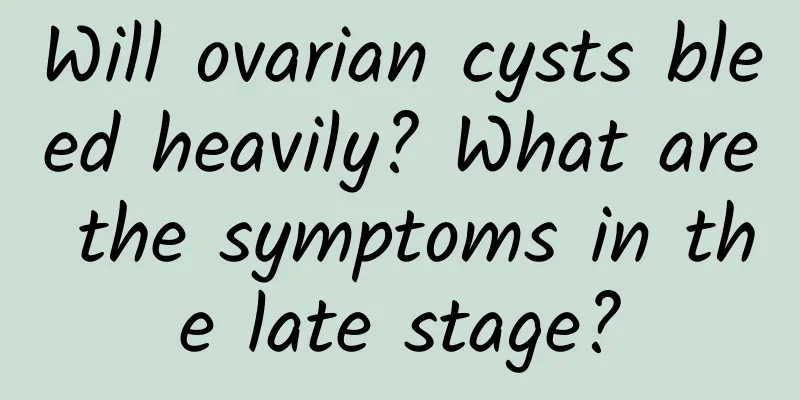How to diagnose ovarian cysts

|
Differential diagnosis of ovarian cysts? We need to grasp the differential diagnosis of ovarian cysts. Only by grasping the differential diagnosis of ovarian cysts can we help everyone to correctly understand and distinguish, so as to come up with accurate treatment methods. So what exactly is the differential diagnosis of ovarian cysts? Let us interpret it in detail below. Differential diagnosis of ovarian cysts: 1. Functional ovarian cyst: This is the most common cyst. It occurs in women of childbearing age during the ovulation cycle. An abnormal amount of fluid accumulates in the follicle or corpus luteum, forming a follicular cyst or corpus luteum cyst. This functional cyst can sometimes be very large, but regardless of whether medication is used or not, it usually disappears on its own within three months. 2. Hemorrhagic ovarian cysts: Sometimes follicular cysts and corpus luteum cysts grow too fast, causing the ovarian tissue to tear and bleed. The blood accumulates in the ovary because there is no outlet, which is called a hemorrhagic cyst. This type of cyst usually disappears on its own, but it takes a long time. If the physical discomfort is more obvious, you can take medicine to alleviate the symptoms. Only in a few cases, when the patient presents more serious symptoms, surgery is required. 3. Serous epithelial cysts and mucinous epithelial cysts: After three months of observation, the cysts that still exist may be epithelial ovarian cysts rather than functional cysts. This is because the serous cells and mucinous cells with secretory functions are buried in the ovaries after ovulation, and they continuously secrete fluid to form cysts. This type of cyst will not disappear and needs to be removed surgically. 4. Chocolate cyst: refers to endometriosis growing in the ovaries, forming a large amount of sticky coffee-colored liquid like chocolate in the ovaries. Because endometriosis will grow larger over time, it will gradually erode normal tissues and cause irreversible damage to ovarian tissues. After evaluating its severity, surgery may be required. 5. Teratoma: This is a very special cyst. It may be a problem with cell differentiation during the embryonic period, and it takes a long time to show up. It will form a collection of hair, teeth, and some oils in the ovary. Since the teratoma itself will not disappear on its own and may continue to grow, and there is a 15% chance of causing ovarian torsion, it is best to remove it as soon as possible. Generally speaking, the rate of malignancy is less than one in a thousand. 6. Ovarian cancer: The chance of developing ovarian cancer is quite low, but because it is located in the pelvic cavity, it is not easy to detect early. 7. Endometrioid tumor: The surface of the tumor is smooth and is often single-chambered. Its inner wall is composed of a layer of tall columnar epithelium that is very similar to the endometrium. The surrounding connective tissue lacks endometrial stroma, and there is no bleeding inside or outside the cyst. |
<<: Early prevention of ovarian cysts
>>: How to check for multiple ovarian cysts
Recommend
Will I die from cervical warts?
The harm of cervical warts in women. Cervical war...
Eat less to lose weight? How to calculate daily calories for weight loss
Everyone knows that to lose weight you need to &q...
Understand the possible side effects before liposuction surgery
Modern people value efficiency at work, and this ...
Cost of initial treatment of cervical precancerous lesions
Cervical precancerous lesions, when people hear t...
Interpretation of the prevention methods of chronic cervicitis
Chronic cervicitis is a common disease among wome...
What are the dangers of threatened abortion?
Threatened abortion is a common and special type ...
Intermittent fasting is very popular, is it suitable for me? Experts: The benefits are certain, here are 5 tips to know before proceeding
● Even if you eat less, if you distribute it even...
How should I regulate my scanty menstrual flow? Is it irregular menstruation?
The treatment for irregular menstruation is gener...
You can still eat oily rice while reducing sugar! Experts reveal their secret recipes, which are resistant to steaming and easy to store, so you don’t need to worry about making multiple portions
Glutinous rice is a high-glycemic starch. Adding ...
How to prevent habitual miscarriage?
Because habitual miscarriage is very harmful, it ...
What are the symptoms of endometritis?
What are the symptoms of endometritis? Is endomet...
Things to note after having an abortion
After the abortion, it is very important to pay a...
Can congenital biliary atresia be detected during prenatal examination?
It is usually difficult to detect congenital bili...
What causes bilateral ovarian cysts?
What are the causes and symptoms of bilateral ova...
Lose weight without gaining it back, Chinese medicine can help! Obesity is divided into 3 categories, and TCM can treat it according to the symptoms
Common types of obesity The causes of obesity are...









